The New Delhi G-20 will be remembered for its personalisation and politicisation by PM Modi
‘One earth, one family, one future’ was the official theme of this year’s G-20 Summit in New Delhi. But for the thousands of delegates from around the world who descended on Bharat Mandapam, the summit venue at Pragati Maidan, the theme could just as well have added: ‘one leader’.
Through the streets of Delhi, and adorning all roads leading to Bharat Mandapam, so ubiquitous was Prime Minister Narendra Modi’s visage, staring down from posters that had popped up every few dozen metres, that some of the visitors from abroad asked if this was “normal in Indian culture”. In both western and Asian democracies, it is quite unusual to see photographs of elected leaders other than inside government offices and official buildings or during elections, they pointed out.
There is much that the September 9-10 New Delhi G-20 Leaders’ Summit will be remembered for. It ended with a stunning diplomatic success for India, producing, amid an extraordinary divide between the West and the Russia-China axis, a consensus in the shape of the New Delhi Declaration.
Arrived at the last minute by India’s team of negotiators under Sherpa Amitabh Kant, the declaration marked the emergence of the Global South as a powerful voice.
The G-20 in New Delhi will particularly be remembered for the inclusion of the African Union as the group’s latest member, as the 55-nation union becomes only the second regional bloc after the European Union.
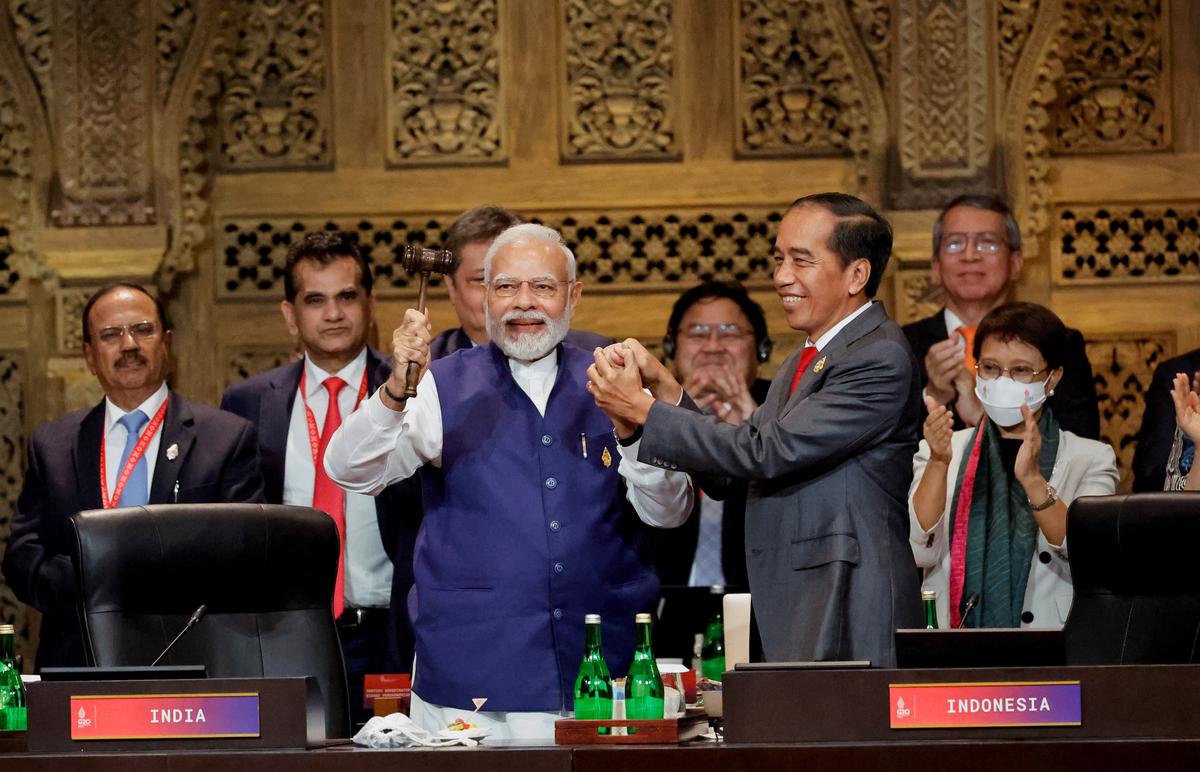
India’s Prime Minister Narendra Modi and Indonesia’s President Joko Widodo at last year’s G20 summit in Bali. | Photo Credit: Reuters
But beyond the diplomacy, the G-20 will also be remembered for the extraordinary personalisation of what is, in essence, an annual multilateral gathering of world leaders. A personalisation and politicisation that hasn’t been done by any previous host of the G-20, including last year’s host, Indonesian President Joko Widodo, who pulled off a summit, with a declaration, and without heralding it as a major political triumph.
The Hangzhou precedent
Perhaps the only comparable politicisation of a G-20 summit was by China and its leader Xi Jinping. In 2016, Chinese organisers made the Hangzhou summit, like everything else in China these days, a tribute to Xi. Hangzhou perhaps rewrote the G-20 playbook and elevated a routine diplomatic affair to a political spectacle. In the days leading up to that summit, and a good four years before COVID-19, China saw its first lockdown — the city was emptied, covered in an extraordinary security blanket, and residents “encouraged” to go on holiday.
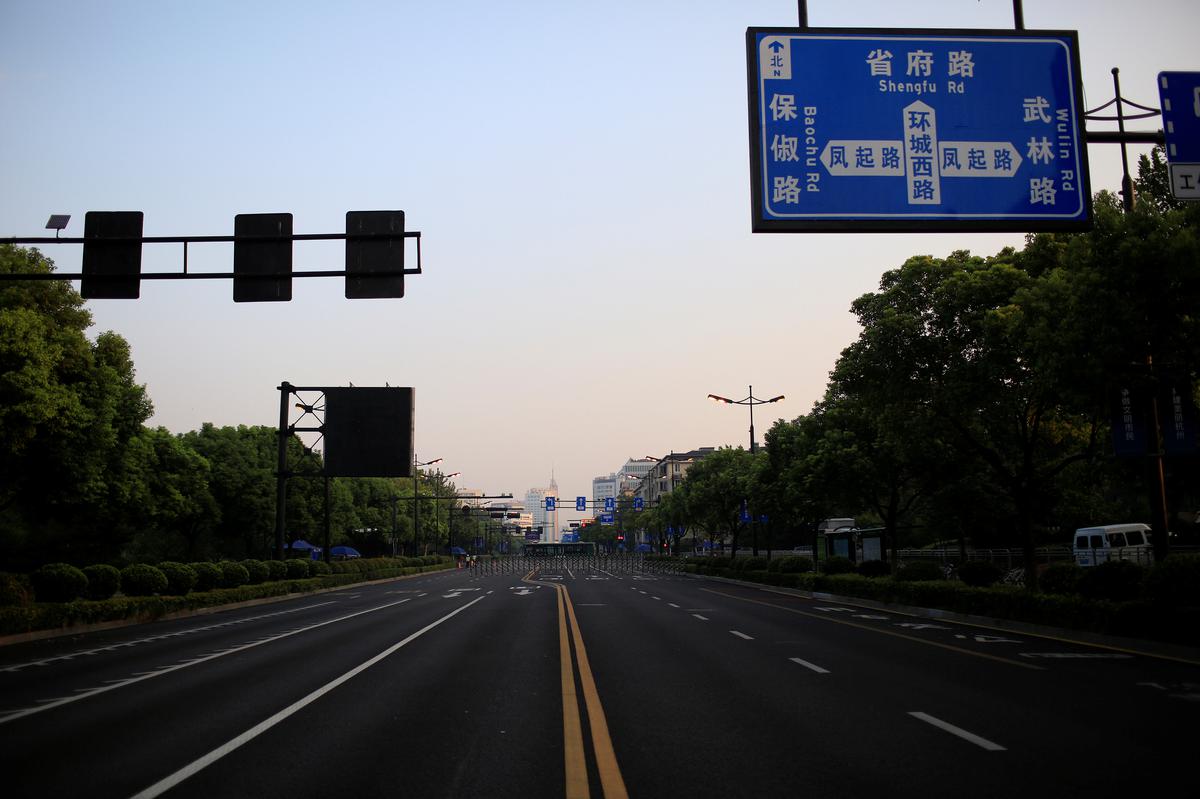
An empty street in Hangzhou, China, after the police closed the area ahead of the 2016 G-20 summit. | Photo Credit: Reuters
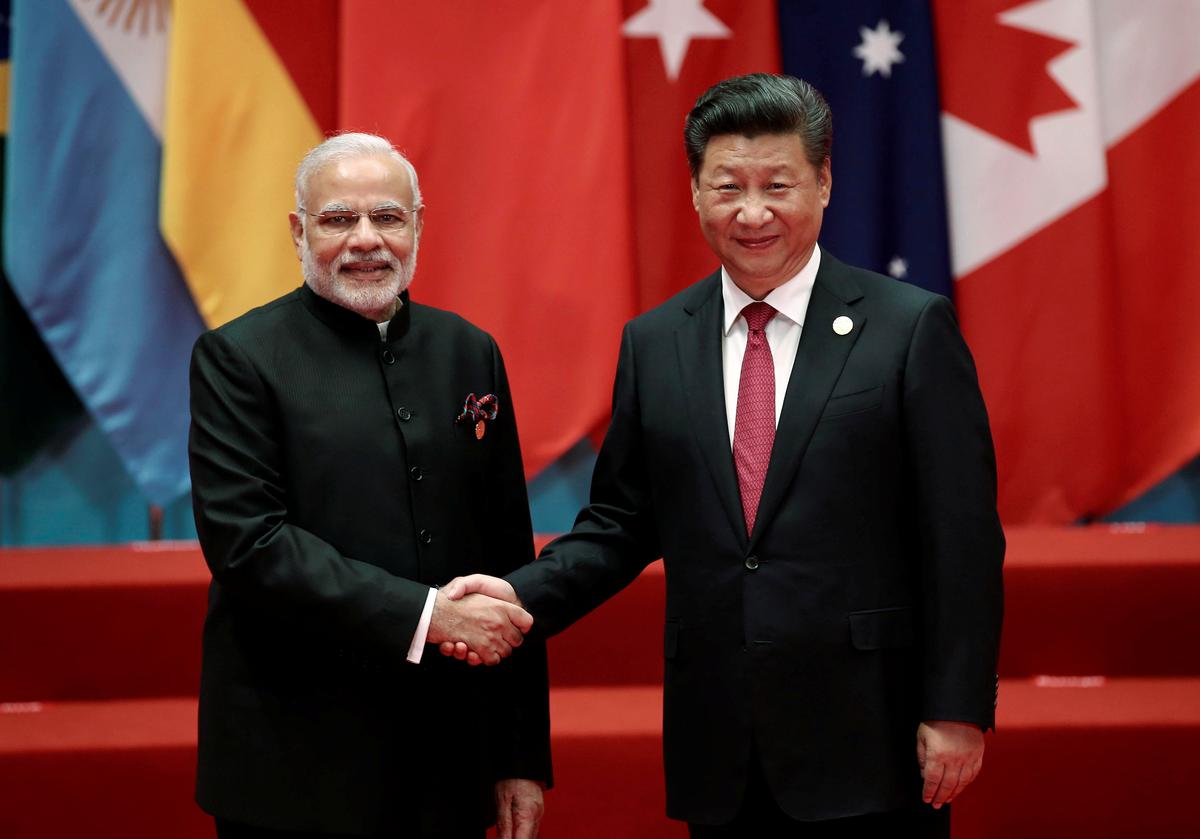
Indian Prime Minister Narendra Modi and Chinese President Xi Jinping at the 2016 G20 summit in Hangzhou, China. | Photo Credit: Reuters
The parallels in Delhi 2023 were striking — a locked-down city and closed small businesses. Yet, even by the standards of Hangzhou, where State media coverage was all about Xi, Delhi took the political adulation to another level. “We didn’t even see this in China with Xi Jinping,” remarked one visiting European journalist wryly.
On their drive from their designated hotels through Delhi’s deserted streets on the G-20 weekend, the image that greeted the capital’s visitors was the face of Modi, and Modi alone, which adorned thousands of hoardings and posters all across the heart of the city. Several diplomats remarked on the fact that there were no photos of any of the other G-20 heads of state attending. The show would have only one star.
The personalisation of the G-20 summit was not just restricted to billboards and photo-ops, however. Officials said that Modi took a deep interest in personally choosing each gift, and each menu, and each experience for leaders at the event. The menus, for instance, were vegetarian, as the Prime Minister himself is, and replete with millets, the chosen grain that India pushed for at the United Nations, to make 2023 the Year of the Millet.
The menu at the Presidential Banquet hosted by Droupadi Murmu, where Modi also welcomed the guests, included “foxtail millet leaf crisps topped with yoghurt and spiced chutney, Kerala red rice tossed with millet crisp and curry leaf, a cardamom scented barnyard millet pudding with fig and peach compote”.
In the G-20 summit declaration too, Indian negotiators fought hard to include the term reportedly coined by Modi for the Millet and other Ancient Grains International Research Initiative — MAHARISHI — although it was eventually only kept in the annexures, and succeeded in including others like ‘Vasudhaiva Kutumbakam’ and ‘women-led development’, that Modi has often highlighted in speeches.
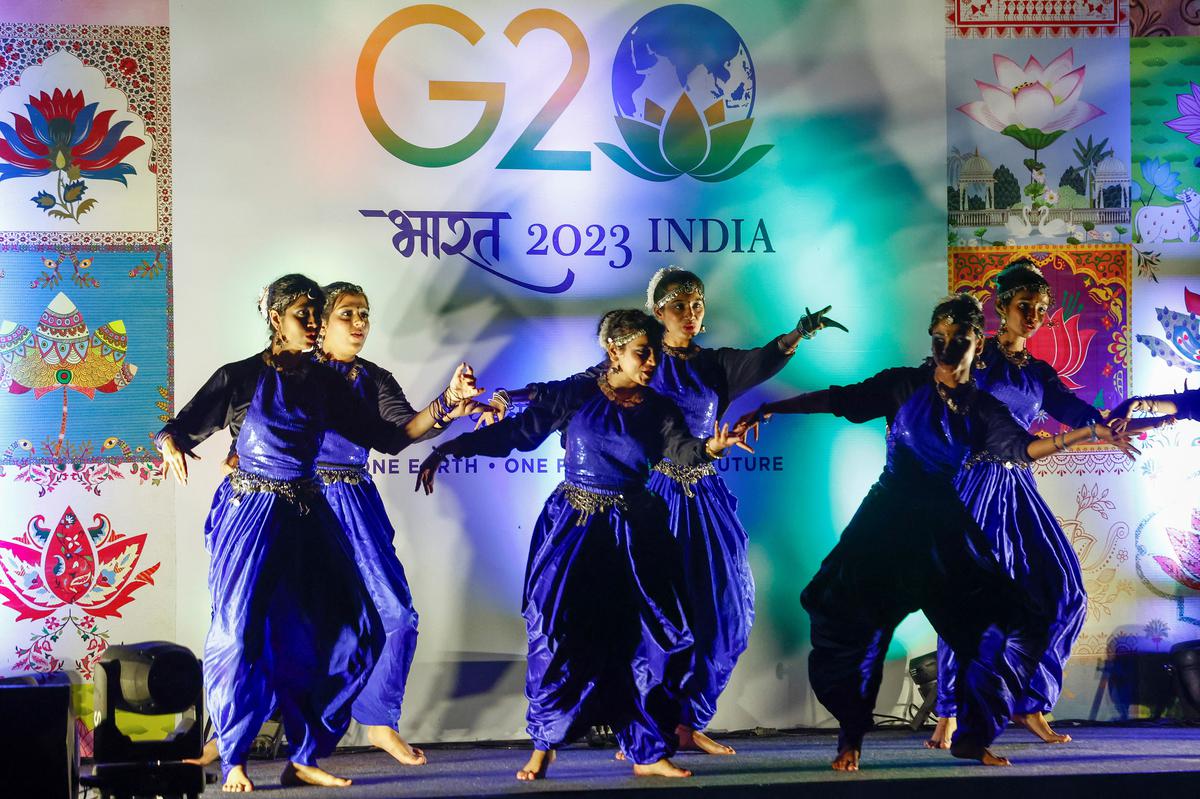
Dancers welcome world leaders to the G20 Summit in New Delhi. | Photo Credit: Reuters
Para 14 of the G-20 New Delhi Leaders’ Declaration records Modi’s famous quote, which Indian negotiators pushed for in the Bali statement: “Today’s era must not be of war” — the statement the Prime Minister made in a meeting with Russian President Vladimir Putin in September 2022. Many also pointed to the G-20 logo, which sits atop a lotus, that bears a remarkable resemblance to Modi’s own ruling party, the BJP’s, election symbol.
Rewards of personalisation
“It’s not news that Modi and this government have a distinctive political style in everything they do. He can make the turning of a tap a mega event,” says academic and columnist Pratap Bhanu Mehta. This isn’t exceptional, he notes, for a government that has “so convinced itself of the power of creating a dominative narrative about everything — even the clothes you wear, the language you speak”. “With the G-20,” he adds, “the scale lends itself to a certain kind of spectacle.”
If the rewards of personalisation — especially with a general election looming next year — are obvious, making the G-20 about Modi was not without risks.
In the weeks leading up to the summit, most observers were convinced that given the sharp divisions between the West on the one hand, and Russia and China on the other, over the language regarding the war in Ukraine, a consensus would elude the G-20 for the first time in its history.
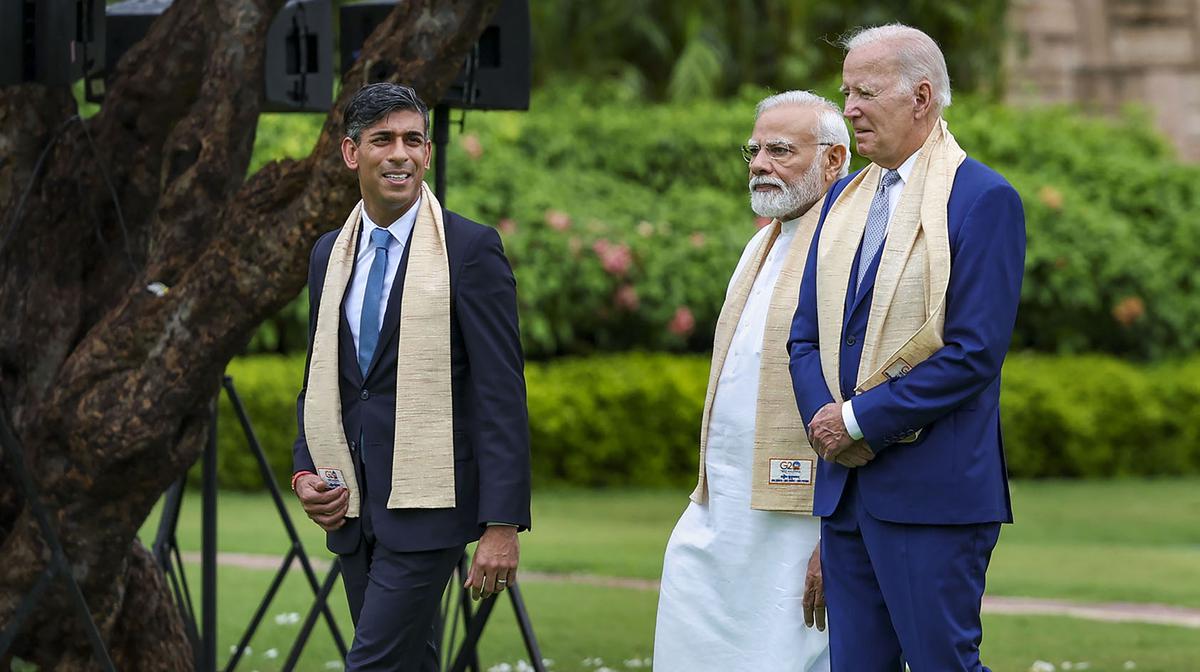
(L to R) British Prime Minister Rishi Sunak, India’s Prime Minister Narendra Modi and U.S. President Joe Biden on the final day of the G20 Summit in New Delhi, September 10, 2023. | Photo Credit: PTI
Not issuing a New Delhi Declaration — particularly after the enormous political capital spent on the G-20 and its direct association with the Prime Minister — would have been seen as a leadership failure too.
“It’s very hard to take away from the fact that Modi has, in that sense, a major political success,” says Mehta. “The core thing here — and I think he will get domestic credit for it — is he has managed to make a statement that the rest of the world wants to go out of its way to court India. When you have every major political leader bend over backwards to shower praise on him, and it is praise to him, in any political context it will be a big deal.”
And the Modi government has certainly capitalised on this. The most dramatic moment of the summit was when the Prime Minister interrupted proceedings to make the announcement that against the odds, an agreement had been reached at the last minute.
Soon after, officials and diplomats of the Ministry of External Affairs were deployed to make it clear that the only reason an agreement was reached was because of the Prime Minister’s forceful and charismatic interventions with other world leaders. “It is a combination of Modi ki guarantee and Modi ka magic,” said a senior official.
If making the G-20 about Modi, especially in a bitterly divided world, was a high-risk political gamble, it certainly paid off — and spectacularly.
The ‘Bharat’ that is India
When Prime Minister Narendra Modi addressed the G-20 Summit, the country tag placed before him, for the first time in G-20 history, did not say India, but Bharat. This was the latest — and clearest — indicator of the government’s growing preference to use Bharat on official platforms, coming days after President Droupadi Murmu had, in a dinner invitation to visiting delegates, used the title President of Bharat.
The most common question at the G-20’s sprawling media centre from the curious — and somewhat confused — members of the foreign press was, “Is India being renamed?” Perhaps anticipating the confusion, scattered throughout the venue was a shiny green magazine, produced by the Government of India, explaining the origins of “Bharat: The Mother of Democracy”.
“In Bharat that is India,” it began, “the view or the will of the people in governance has been the central part of life since earliest recorded history… Bharat is the official name of the country. It is mentioned in the Constitution as also in the discussions of 1946-48.” It goes on to present a brief, brochure-size history of India, which it says began with the “Sindhu-Saraswati civilisation in 6000 BCE”.
The publication ends with a list of India’s Prime Ministers from Nehru to Modi. “Elections happened,” it assures its readers, “and keep happening like clockwork.”
New Delhi G-20 summit | How PM Modi turned an annual diplomatic event into a grand political spectacle
The New Delhi G-20 will be remembered for its personalisation and politicisation by PM Modi
‘One earth, one family, one future’ was the official theme of this year’s G-20 Summit in New Delhi. But for the thousands of delegates from around the world who descended on Bharat Mandapam, the summit venue at Pragati Maidan, the theme could just as well have added: ‘one leader’.
Through the streets of Delhi, and adorning all roads leading to Bharat Mandapam, so ubiquitous was Prime Minister Narendra Modi’s visage, staring down from posters that had popped up every few dozen metres, that some of the visitors from abroad asked if this was “normal in Indian culture”. In both western and Asian democracies, it is quite unusual to see photographs of elected leaders other than inside government offices and official buildings or during elections, they pointed out.
There is much that the September 9-10 New Delhi G-20 Leaders’ Summit will be remembered for. It ended with a stunning diplomatic success for India, producing, amid an extraordinary divide between the West and the Russia-China axis, a consensus in the shape of the New Delhi Declaration.
Arrived at the last minute by India’s team of negotiators under Sherpa Amitabh Kant, the declaration marked the emergence of the Global South as a powerful voice.
The G-20 in New Delhi will particularly be remembered for the inclusion of the African Union as the group’s latest member, as the 55-nation union becomes only the second regional bloc after the European Union.

India’s Prime Minister Narendra Modi and Indonesia’s President Joko Widodo at last year’s G20 summit in Bali. | Photo Credit: Reuters
But beyond the diplomacy, the G-20 will also be remembered for the extraordinary personalisation of what is, in essence, an annual multilateral gathering of world leaders. A personalisation and politicisation that hasn’t been done by any previous host of the G-20, including last year’s host, Indonesian President Joko Widodo, who pulled off a summit, with a declaration, and without heralding it as a major political triumph.
The Hangzhou precedent
Perhaps the only comparable politicisation of a G-20 summit was by China and its leader Xi Jinping. In 2016, Chinese organisers made the Hangzhou summit, like everything else in China these days, a tribute to Xi. Hangzhou perhaps rewrote the G-20 playbook and elevated a routine diplomatic affair to a political spectacle. In the days leading up to that summit, and a good four years before COVID-19, China saw its first lockdown — the city was emptied, covered in an extraordinary security blanket, and residents “encouraged” to go on holiday.

An empty street in Hangzhou, China, after the police closed the area ahead of the 2016 G-20 summit. | Photo Credit: Reuters

Indian Prime Minister Narendra Modi and Chinese President Xi Jinping at the 2016 G20 summit in Hangzhou, China. | Photo Credit: Reuters
The parallels in Delhi 2023 were striking — a locked-down city and closed small businesses. Yet, even by the standards of Hangzhou, where State media coverage was all about Xi, Delhi took the political adulation to another level. “We didn’t even see this in China with Xi Jinping,” remarked one visiting European journalist wryly.
On their drive from their designated hotels through Delhi’s deserted streets on the G-20 weekend, the image that greeted the capital’s visitors was the face of Modi, and Modi alone, which adorned thousands of hoardings and posters all across the heart of the city. Several diplomats remarked on the fact that there were no photos of any of the other G-20 heads of state attending. The show would have only one star.
The personalisation of the G-20 summit was not just restricted to billboards and photo-ops, however. Officials said that Modi took a deep interest in personally choosing each gift, and each menu, and each experience for leaders at the event. The menus, for instance, were vegetarian, as the Prime Minister himself is, and replete with millets, the chosen grain that India pushed for at the United Nations, to make 2023 the Year of the Millet.
The menu at the Presidential Banquet hosted by Droupadi Murmu, where Modi also welcomed the guests, included “foxtail millet leaf crisps topped with yoghurt and spiced chutney, Kerala red rice tossed with millet crisp and curry leaf, a cardamom scented barnyard millet pudding with fig and peach compote”.
In the G-20 summit declaration too, Indian negotiators fought hard to include the term reportedly coined by Modi for the Millet and other Ancient Grains International Research Initiative — MAHARISHI — although it was eventually only kept in the annexures, and succeeded in including others like ‘Vasudhaiva Kutumbakam’ and ‘women-led development’, that Modi has often highlighted in speeches.

Dancers welcome world leaders to the G20 Summit in New Delhi. | Photo Credit: Reuters
Para 14 of the G-20 New Delhi Leaders’ Declaration records Modi’s famous quote, which Indian negotiators pushed for in the Bali statement: “Today’s era must not be of war” — the statement the Prime Minister made in a meeting with Russian President Vladimir Putin in September 2022. Many also pointed to the G-20 logo, which sits atop a lotus, that bears a remarkable resemblance to Modi’s own ruling party, the BJP’s, election symbol.
Rewards of personalisation
“It’s not news that Modi and this government have a distinctive political style in everything they do. He can make the turning of a tap a mega event,” says academic and columnist Pratap Bhanu Mehta. This isn’t exceptional, he notes, for a government that has “so convinced itself of the power of creating a dominative narrative about everything — even the clothes you wear, the language you speak”. “With the G-20,” he adds, “the scale lends itself to a certain kind of spectacle.”
If the rewards of personalisation — especially with a general election looming next year — are obvious, making the G-20 about Modi was not without risks.
In the weeks leading up to the summit, most observers were convinced that given the sharp divisions between the West on the one hand, and Russia and China on the other, over the language regarding the war in Ukraine, a consensus would elude the G-20 for the first time in its history.

(L to R) British Prime Minister Rishi Sunak, India’s Prime Minister Narendra Modi and U.S. President Joe Biden on the final day of the G20 Summit in New Delhi, September 10, 2023. | Photo Credit: PTI
Not issuing a New Delhi Declaration — particularly after the enormous political capital spent on the G-20 and its direct association with the Prime Minister — would have been seen as a leadership failure too.
“It’s very hard to take away from the fact that Modi has, in that sense, a major political success,” says Mehta. “The core thing here — and I think he will get domestic credit for it — is he has managed to make a statement that the rest of the world wants to go out of its way to court India. When you have every major political leader bend over backwards to shower praise on him, and it is praise to him, in any political context it will be a big deal.”
And the Modi government has certainly capitalised on this. The most dramatic moment of the summit was when the Prime Minister interrupted proceedings to make the announcement that against the odds, an agreement had been reached at the last minute.
Soon after, officials and diplomats of the Ministry of External Affairs were deployed to make it clear that the only reason an agreement was reached was because of the Prime Minister’s forceful and charismatic interventions with other world leaders. “It is a combination of Modi ki guarantee and Modi ka magic,” said a senior official.
If making the G-20 about Modi, especially in a bitterly divided world, was a high-risk political gamble, it certainly paid off — and spectacularly.
The ‘Bharat’ that is India
When Prime Minister Narendra Modi addressed the G-20 Summit, the country tag placed before him, for the first time in G-20 history, did not say India, but Bharat. This was the latest — and clearest — indicator of the government’s growing preference to use Bharat on official platforms, coming days after President Droupadi Murmu had, in a dinner invitation to visiting delegates, used the title President of Bharat.
The most common question at the G-20’s sprawling media centre from the curious — and somewhat confused — members of the foreign press was, “Is India being renamed?” Perhaps anticipating the confusion, scattered throughout the venue was a shiny green magazine, produced by the Government of India, explaining the origins of “Bharat: The Mother of Democracy”.
“In Bharat that is India,” it began, “the view or the will of the people in governance has been the central part of life since earliest recorded history… Bharat is the official name of the country. It is mentioned in the Constitution as also in the discussions of 1946-48.” It goes on to present a brief, brochure-size history of India, which it says began with the “Sindhu-Saraswati civilisation in 6000 BCE”.
The publication ends with a list of India’s Prime Ministers from Nehru to Modi. “Elections happened,” it assures its readers, “and keep happening like clockwork.”







NO COMMENT